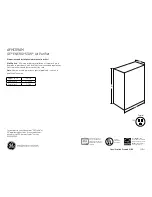
20
• Auxiliary/Secondary Limit
A dirty filter, excessive duct static, insufficient air flow, a
faulty limit, or a failed circulator blower can cause this
limit to open. Check filters, total external duct static,
circulator blower motor, blower motor speed tap (see
wiring diagram), and limit. An interruption in electrical
power during a heating cycle may also cause the auxil-
iary limit to open. The automatic reset secondary limit is
located on top of the circulator blower assembly.
• Rollout Limit
If the burner flames are not properly drawn into the
heat exchanger, the flame rollout protection device will
open. Possible causes are restricted or blocked flue
passages, blocked or cracked heat exchanger, a failed
induced draft blower, or insufficient combustion air. The
rollout protection device is a manual reset limit located
on the burner bracket. The cause of the flame rollout
must be determined and corrected before resetting the
limit.
• Check wiring
Check wiring for opens/shorts and miswiring.
IMPORTANT NOTE: If you have to frequently reset
your gas/electric package unit, it means that a
problem exists that should be corrected. Contact
a qualified servicer for further information.
Pressure Switch Stuck Open
A pressure switch stuck open can be caused by a faulty
pressure switch, faulty wiring, a disconnected or damaged
hose, a blocked or restricted flue, a blocked pressure tap or
a faulty induced draft blower.
If the control senses an open pressure switch during the
pre-purge cycle, the induced draft blower only will be ener-
gized. If the pressure switch opens after ignition has begun
the gas valve is de-energized, the circulator blower heat
off cycle begins, and the ‘induced draft blower remains on.
The diagnostic LED (red) code is two (2) flashes.
Pressure Switch Stuck Closed
A stuck closed pressure switch can be caused by a faulty
pressure switch or faulty wiring. If the control encounters
a pressure switch stuck closed, the induced draft blower
remains off. The diagnostic red LED code for this fault is
three (3) flashes.
Primary Limit
A primary limit will open due to excessive supply air tem-
peratures. This can be caused by a dirty filter, excessive
duct static, insufficient air flow, or a faulty limit. Check filters,
total external duct static, blower motor, blower motor speed
tap (see wiring diagram), and limit. This limit will automatical
-
ly reset once the temperature falls below a preset level.
If a limit switch opens, the gas valve is immediately de-en-
ergized, the induced draft and air circulating blowers are
energized. The induced draft and air circulator blowers
remain energized until the limit switch re-closes. The diag-
nostic LED (red) code for an open limit is four (4) flashes.
NOTE: If the primary limit opens five (5) times with-
in the same call for heat, the ignition control will
lock out for one (1) hour with the air circulating
blower energized at high heat speed. The diagnos-
tic LED (red) code for this condition is seven (7)
flashes.
Flame Detected with Gas Valve Closed
If flame is detected with the gas valve de-energized, the
combustion and air circulator blowers are energized. The
diagnostic fault code is five (5) flashes (red LED) for this
condition. The flame diagnostic LED (amber) will flash (2)
times to indicate this condition. The control can be reset by
removing the power supply to the unit or it will automatically
reset after one hour. Miswiring is the probable cause for this
fault.
Low Flame Signal
Under some conditions, the fuel or air supply can create a
nearly invisible coating on the flame sensor. This coating
acts as an insulator causing a drop in the flame signal. If
the flame signal drops below a predetermined value, the
ignition control will display an error code of (1) flash on the
amber diagnostic LED. The unit will continue to operate
until the control can no longer detect flame.
Abnormal Operation - Cooling
Short Cycle Compressor Delay
The automatic ignition control has a built-in feature that
prevents damage to the compressor in short cycling situ-
ations. In the event of intermittent power losses or inter-
mittent thermostat operation, the ignition control will delay
output to the compressor contactor for three minutes from
the time power is restored or thermostat call for cooling is
restored. (Compressor is off a total of three minutes). The
diagnostic red LED will flash six (6) times to indicate the
compressor contactor output is being delayed.
NOTE: Some electronic thermostats also have a
built-in compressor short cycle timer that may be
longer than the three minute delay given above.
If you are using an electronic thermostat and the
compressor has not started after three minutes,
wait an additional five minutes to allow the ther-
mostat to complete its short cycle delay time.
High Pressure Switch/Loss of Charge Switch
Some models include a high pressure cutout switch and/
or a loss of charge cutout switch. The high pressure cutout
switch protects the refrigeration system from excessive
operating pressures. The loss of charge cutout switch
protects the refrigeration system from very low operating
pressures due to a loss of refrigerant. Compressor oper-
ation will be disabled if either of these devices opens. If
either devices opens, the diagnostic red LED will flash (9)
times to indicate that a refrigeration system pressure switch
is open.













































